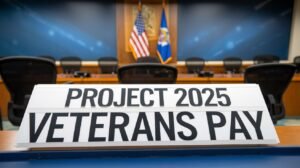Understanding Project 2025 FDIC: And Its Impact on the FDIC
Introduction
As the political landscape shifts with each election cycle, new proposals emerge that could significantly change how our financial systems operate. One such initiative is Project 2025, which aims to reshape various government agencies, including the Federal Deposit Insurance Corporation (FDIC). This article delves into what Project 2025 FDIC entails, its potential implications for the FDIC, and why it matters to everyday Americans.
What is Project 2025 FDIC?
Project 2025 is an extensive initiative crafted by The Heritage Foundation, a conservative think tank. Its goal is to reorganize federal agencies to create what its proponents believe will be a more efficient and effective government. This initiative is especially relevant as we approach the 2024 presidential election, where discussions about government reform are heating up.
The concept of Project 2025 FDIC revolves around the idea that a more streamlined regulatory framework could enhance the banking sector’s efficiency. However, how this proposal will be executed and what it will mean for consumers remains to be seen.
The FDIC: A Quick Overview
Before we discuss the specifics of Project 2025 FDIC, it’s essential to understand the FDIC’s role. Established in 1933 in response to the Great Depression, the FDIC protects bank depositors by insuring deposits up to $250,000 per bank. This insurance helps maintain public confidence in the banking system, especially during economic downturns.
The FDIC’s role is critical. It is a safety net for millions of Americans, ensuring their life savings are secure even in a bank failure.
The Merger Proposal
One of the significant elements of Project 2025 FDIC is its proposal to merge the FDIC with other federal banking agencies. This idea has sparked considerable debate. Proponents argue that a merger could streamline operations and reduce bureaucratic inefficiencies. However, critics worry that this could jeopardize the effectiveness of deposit insurance.
Merging the FDIC with agencies like the Office of the Comptroller of the Currency and the National Credit Union Administration raises concerns about maintaining a focused approach to consumer protection. If the FDIC’s mission becomes diluted amid broader regulatory responsibilities, the safety of depositors may be compromised.
How Would This Affect Deposit Insurance?
The question on everyone’s mind is: what does Project 2025 FDIC mean for government-backed deposit insurance? While Project 2025 does not explicitly call for eliminating the FDIC, the specifics of how the merger would work remain vague. Would deposit insurance remain intact, or would it be modified?
Historical Context
We must consider the historical context to grasp the potential impact of Project 2025 FDIC. The FDIC was created to restore trust in the banking system after widespread bank failures. It’s a safety net that has helped prevent bank runs during financial crises. Any discussion about altering this system must take these historical lessons into account.
The foundation of Project 2025 FDIC is built on the idea that banking regulations can be improved, but historical failures remind us that cutting corners on consumer protection can lead to catastrophic consequences.
The Economic Implications of Project 2025
So, what could the economic implications of Project 2025 FDIC be? Merging the FDIC with other agencies could change how banks are regulated. For instance, proponents suggest that reducing regulatory burdens could encourage more lending and stimulate economic growth. However, there’s a flip side to this coin. Less regulation might also lead to riskier banking practices.
A Balancing Act
Achieving the right balance between regulation and freedom is essential. Too much deregulation can create a Wild West scenario, while too much regulation can stifle innovation. The challenge lies in ensuring that changes under Project 2025 FDIC don’t compromise the safety and soundness of our financial system.
Concerns from Experts
Experts have voiced concerns about the proposals in Project 2025 FDIC. Some argue that merging the FDIC with other agencies might dilute its focus on consumer protection. If the FDIC’s mission becomes overshadowed by other regulatory responsibilities, depositors could find themselves at greater risk.
Dr. Joseph J. Cordes, an economist at George Washington University, emphasizes that deposit insurance is crucial for maintaining confidence in the banking system. Any proposed changes should carefully consider the implications for public trust.
The Public’s Perspective
Public sentiment about changes in banking regulations is often mixed. Many people appreciate the safety net provided by the FDIC but may need help understanding how it works. With Project 2025 FDIC on the table, engaging the public in conversations about what these changes might mean for their financial security is crucial.
Informing the Public
Educational campaigns could help demystify the FDIC’s role and the implications of Project 2025 FDIC. If people understand that their savings are protected, they may feel more secure. Conversely, if they sense that protection could diminish, panic could ensue.
Communicating the potential changes and their effects can go a long way in preventing misinformation and fear among depositors.
The Political Landscape
Project 2025 FDIC is not happening in a vacuum. The political environment leading up to the 2024 election is charged. Discussions about government size, regulation, and the role of federal agencies are at the forefront of political debates. Understanding where candidates stand on these issues can help voters make informed choices.
The Role of Political Parties
Both major political parties have different views on regulation. While conservatives often advocate for reducing government intervention, progressives typically emphasize the need for regulation to protect consumers. The future of the FDIC may very well hinge on which party gains power in the upcoming election.
This division underscores the need for public awareness about Project 2025 FDIC and how it may alter the landscape of financial security.
A Little Humor
Let’s lighten the mood amid all the serious discussions about Project 2025 FDIC. Imagine if the FDIC had a mascot—perhaps a friendly bank teller named “Savings Sally” who spreads the word about deposit insurance! It’s hard to picture her in a merger meeting, advocating for more protection while juggling bank policies. Humor aside, creating a relatable narrative could help demystify these complex issues for the public.
What Happens Next?
As we await further developments related to Project 2025 FDIC, monitoring political and public responses is essential. Advocacy groups, financial institutions, and consumers will likely weigh in on proposed changes, shaping the conversation around the FDIC’s future.
Monitoring the Merger
If Project 2025 FDIC moves forward, monitoring how the merger impacts deposit insurance and consumer protection will be crucial. Transparency will be vital; the public should know how regulation changes could affect their savings.
Regulatory bodies should engage with stakeholders and the public to ensure a thorough understanding of proposed changes and their implications.
Conclusion
In summary, Project 2025 FDIC proposes significant changes that could reshape the landscape of federal banking agencies, particularly the FDIC. While streamlining operations and reducing regulatory burdens may sound appealing, it’s essential to approach these changes with caution. The safety and security of deposits should remain a top priority.
As we navigate this complex terrain, informed discussions and public engagement are vital. The future of the FDIC—and the financial security of millions—hangs in the balance. Let’s ensure that any changes made serve to protect consumers rather than expose them to more significant risks. After all, our financial peace of mind is no laughing matter!
Understanding Project 2025 FDIC is crucial in a world of uncertainties. Stay informed, stay engaged, and remember: your savings deserve the best protection possible!














Post Comment